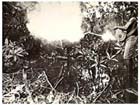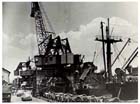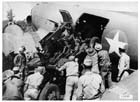New Guinea was one of the most inhospitable places in the world during the Second World War. The dense jungle and rugged highlands presented a huge physical obstacle to both the Japanese and Allied forces. Apart from a few towns on the coast, New Guinea lacked any modern infrastructure: There were no roads going into the interior and only a small number of very basic airstrips scattered across the country. This meant that most places inland could only be reached on foot via crude tracks. Movement became an endurance test of an individual's ability to march through steaming rain forests and up mud-drenched mountain slopes. Soldiers were often exhausted by the terrain before they even reached the enemy.
Tropical disease added to the soldiers' misery. Malaria, Dengue Fever and Scrub Typhus were common to New Guinea and all were potentially fatal. Soldiers who survived these diseases were left badly weakened and often suffered permanent ill health as a result. Significant efforts were made by medical officers on both sides to get their troops to take preventative measures against mosquitos and other sources of infection but these were never entirely successful. Dysentery was also rife amongst the opposing armies and while it was not unique to New Guinea the primitive conditions there made it harder to control.
The lack of infrastructure was matched by a lack of resources of all kinds. All the weapons, ammunition and equipment used by the Japanese and Allied soldiers had to be transported to New Guinea by ship and then carried inland (a job usually carried out by Papuan and New Guinean men although the Japanese used Formosan [Taiwanese] and Korean labour troops as well). The Allies made some use of transport aircraft as the war went on but there were never enough of them to deliver more than a tiny proportion of what was needed. Equally important was the delivery of food and medical supplies to the troops. There were no farms to speak of in New Guinea and the local villages produced enough to feed themselves and little else. With armies of up to 150,000 men in the field at any one time the Japanese and the Allies needed to ship in virtually all of their food as well. (As the war progressed the Japanese garrisons on New Britain and Bougainville did manage to establish vegetable gardens which enabled them to survive - as opposed to fight - as long as they stayed put and avoided battle with Allied forces).
Supplying all of these things required a massive logistical effort that sometimes proved to be beyond the capabilities of the Japanese and Allied forces. Ships could be sunk or simply unavailable due to demands in other theatres of the war. Even when cargoes were safely landed at places like Port Moresby or Salamaua they still had to be delivered to the frontlines and the limited loads that human carrier lines could bear frequently led to the creation of bottlenecks in the supply chain. Shortages of food at the front left men prey to malnutrition which, if combined with the effects of disease and exhaustion, usually proved fatal. This is exactly what happened to large numbers of Japanese soldiers, particularly in the last two years of the war when virtually all links between Japan and New Guinea were severed by the Allied navies.
The New Guinea environment inflicted great physical hardship upon the soldiers of both sides. Everything used by the soldiers had to be shipped in from offshore at great risk and expense. Getting those supplies from the ports to the fighting troops was even more difficult. The harsh terrain, tropical diseases and fragile supply lines made New Guinea one of the most difficult places to fight in the world.

AWM 077980

AWM 082139

AWM 074285

AWM 015100
